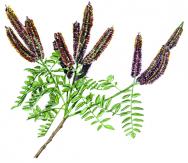False Indigo - Amorpha fruticosa
This bush is covered with a rich foliage which it loses during the winter season. Each leaf is composed of from 13-17 smaller leaflets with an elliptical blade.
The False Indigo belongs to the Leguminosae Family; the tips of its branches bear numerous tiny flowers with violet petals, gathered together in a spike shaped inflorescence. The fruits are tiny glandular, acorn-like legumes about 1 cm long.
The plant originally came from north America, now it grows wild and is widespread in marshlands and along the banks and beds of rivers.
It is a rustic species and very competitive, capable of producing masses of seeds and has become a pest in many wetlands and marshes where, with its infesting nature, it is replacing the autochthonous vegetation, causing serious damage to the natural ecosystems.
At the Fucecchio Marshes it is known as "Gaggìa" and was introduced for the craft of making demi-johns: by spreading so swiftly, it has colonised the banks that cross the Marshes and especially the marshlands with large sedges which grow at Lake Sibolla and in the natural wet valley at the Ramone Marshlets.




